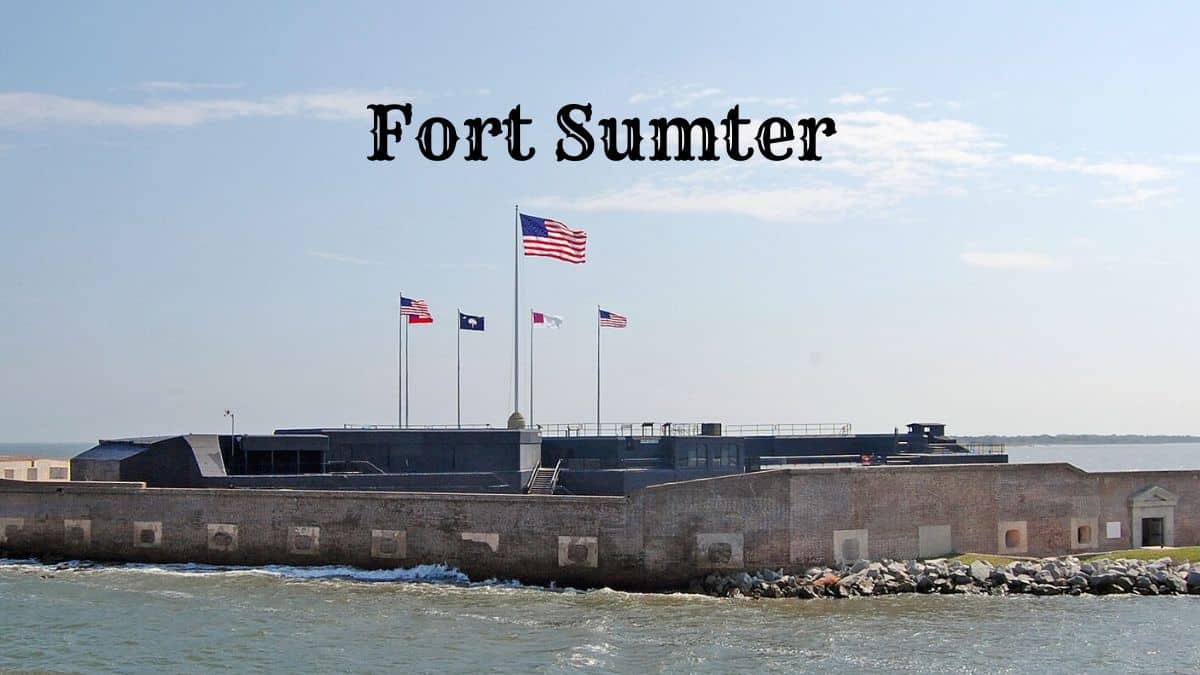Fort Sumter, located in Charleston Harbor, South Carolina, is significant in American history.
On April 12, 1861, the first shots of the Civil War were fired here, marking the beginning of a conflict that would shape the future of the United States.
The fort, a symbol of federal authority, was a focal point for the rising tensions between the North and South.
Union troops, led by Major Robert Anderson, faced a Confederate bombardment, and as a result, Fort Sumter became an enduring symbol of the deep divisions within the nation.
Today, visitors to Fort Sumter can explore its well-preserved ruins and gain insight into the early days of the Civil War.
History of Fort Sumter (South Carolina)
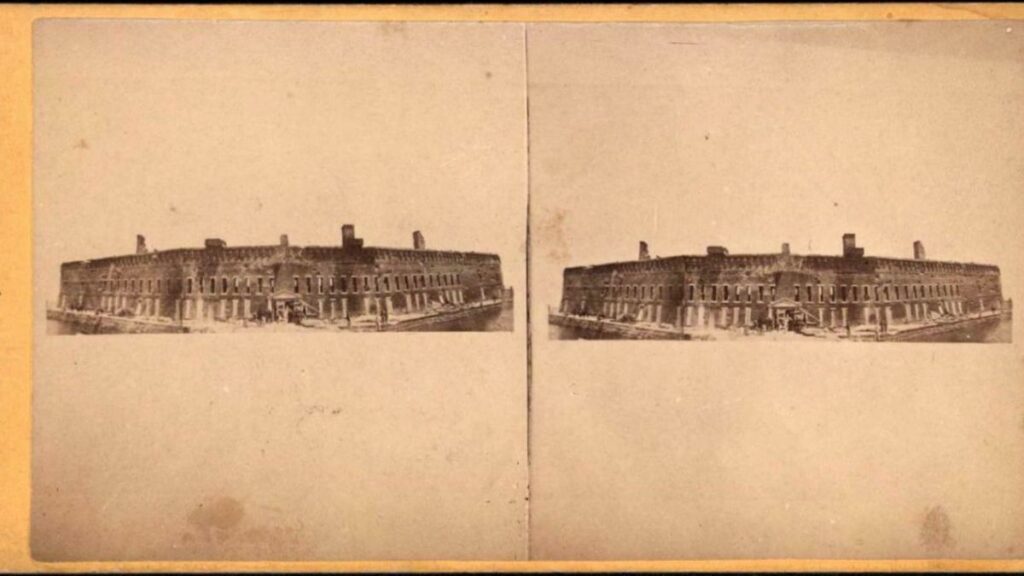
Fort Sumter was pivotal in American history, particularly during the Civil War. Understanding its construction, the events leading up to the Civil War, and the key figures involved is crucial to understanding its importance.
Precursors to Construction
Fort Sumter’s construction began in 1829 as part of a series of coastal fortifications. This was in response to coastal vulnerabilities identified after the War of 1812.
The site was chosen for its strategic position at the entrance of Charleston Harbor, South Carolina.
Although construction faced numerous delays, including funding shortages and labor disputes, the fort was partially completed by 1860. Despite these setbacks, the purpose was clear: to protect one of the South’s most vital ports.
Secession and the Outbreak of Civil War
The situation at Fort Sumter drastically shifted in December 1860 when South Carolina seceded from the Union.
Major Robert Anderson, commanding Union forces in Charleston, relocated his small garrison to Fort Sumter, considering it more defensible.
The fort quickly became a symbol of federal authority amidst growing tensions.
On April 12, 1861, Confederate forces opened fire, initiating the Battle of Fort Sumter and marking the beginning of the Civil War. After 34 hours of bombardment, Anderson surrendered the fort.
This event galvanized the North and the South, leading to a full-scale war.
Key Figures
Major Robert Anderson, a Union officer, played a significant role in the events at Fort Sumter. His strategic decision to move his garrison to the fort put him in direct conflict with Confederate forces.
Confederate General P.G.T. Beauregard commanded the forces that fired the first shots of the Civil War. His leadership was crucial in the Confederate victory at Fort Sumter.
These individuals, among others, shaped the early days of the Civil War and Fort Sumter’s pivotal role in American history.
Strategic Location of Fort Sumter
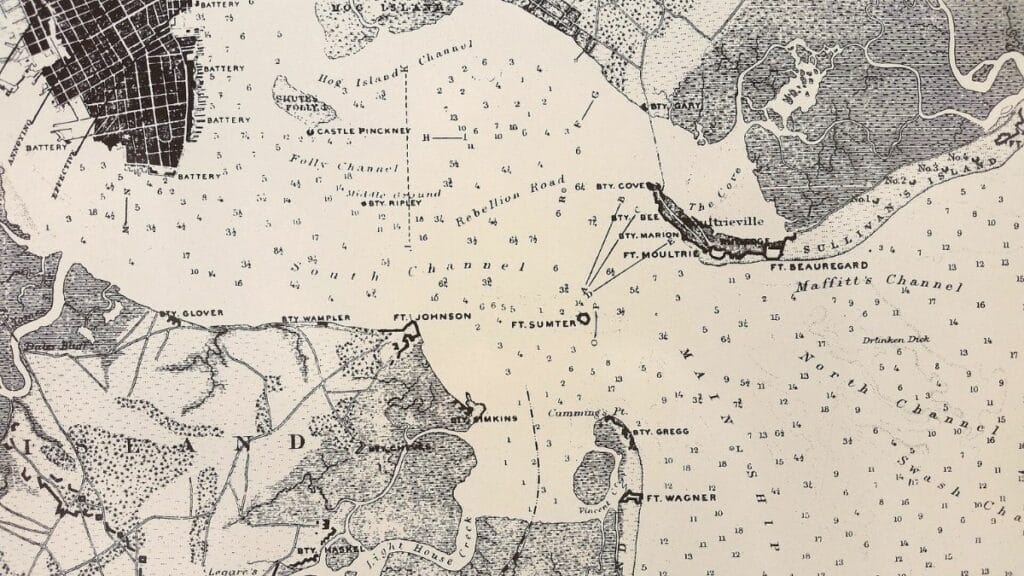
Fort Sumter held significant strategic importance due to its location and role during key military events in the Civil War. Its placement in Charleston Harbor made it a focal point for siege and bombardment activities.
Fort Sumter’s Location
Fort Sumter is located at the entrance of Charleston Harbor, South Carolina. Its position allowed control over naval access to the harbor, making it a pivotal point for the Union and the Confederacy.
The fort is on an artificial island, bolstered by strong walls and heavy artillery.
Charleston Harbor also featured other key fortifications, such as Fort Moultrie on Sullivan’s Island and fortifications on Morris Island.
This network of defenses contributed to the harbor’s strategic value, making any attempt to control Charleston dependent on securing Fort Sumter.
Military Importance During the Civil War
At the outbreak of the Civil War, Fort Sumter became a symbol of Federal authority in the seceded states. Its control was crucial for both the Union and the Confederacy.
The Union used it as a stronghold to assert dominance over the Southern coastline.
The Confederacy sought to capture Fort Sumter to demonstrate its commitment to independence. Once the Confederate forces initiated the bombardment in April 1861, it marked the beginning of the Civil War.
Fort Sumter’s importance grew as it served as a defensive point for the Confederates against Union naval blockades and assaults.
Siege and Bombardments
The siege and bombardments of Fort Sumter were pivotal events during the Civil War. The initial assault in April 1861 led to the Union surrendering the fort to the Confederates.
Afterward, the fort endured continuous bombardments, especially during the Union’s attempt to retake Charleston Harbor. Heavy artillery from both Morris Island and naval ships targeted Fort Sumter.
The fort remained a critical Confederate defense point despite reduced structural integrity over time. The persistence of the siege highlighted the fort’s strategic value in controlling access to one of the South’s most significant ports.
Fort Sumter’s resilience during these engagements demonstrated both sides’ heightened strategic interest in controlling this critical military asset.
Development and Architecture

Fort Sumter, located in Charleston Harbor, South Carolina, is an iconic symbol of American history. Its development and architecture reflect the military engineering advancements of the 19th century.
Construction of Fort Sumter
Fort Sumter was constructed in 1829 as part of the “Third System” of coastal defenses authorized by the U.S. Congress. It was built on a man-made island composed of granite and other materials from areas close to Charleston.
Workers piled these materials to create a solid foundation supporting the heavy structures needed for defense.
Over the years, the fort’s construction experienced delays, primarily due to funding issues and the challenging environment of the harbor.
Despite these obstacles, much of the fort was completed by the early 1860s. The fort features thick, impressive earthwork walls designed to withstand bombardment and provide a strong defensive position for its garrison.
Design and Defenses
Fort Sumter was designed with strategic military needs, incorporating many elements typical of third-system fortifications.
Its walls, constructed from durable brick, measured up to five feet thick and were backed by several layers of earth to absorb cannon fire.
The fort has three tiers of gun emplacements and holds numerous bombproofs to protect personnel and ammunition from enemy fire.
The design included various bastions, allowing for crossfire and added protection against land or sea attacks. Sophisticated features such as firing ports and casemates provided secure positions for the fort’s artillery.
Today, Fort Sumter is part of the National Historical Park. It was a tremendous military engineering feat of its time and served as a place for public education and remembrance.
The Commencement of Combat
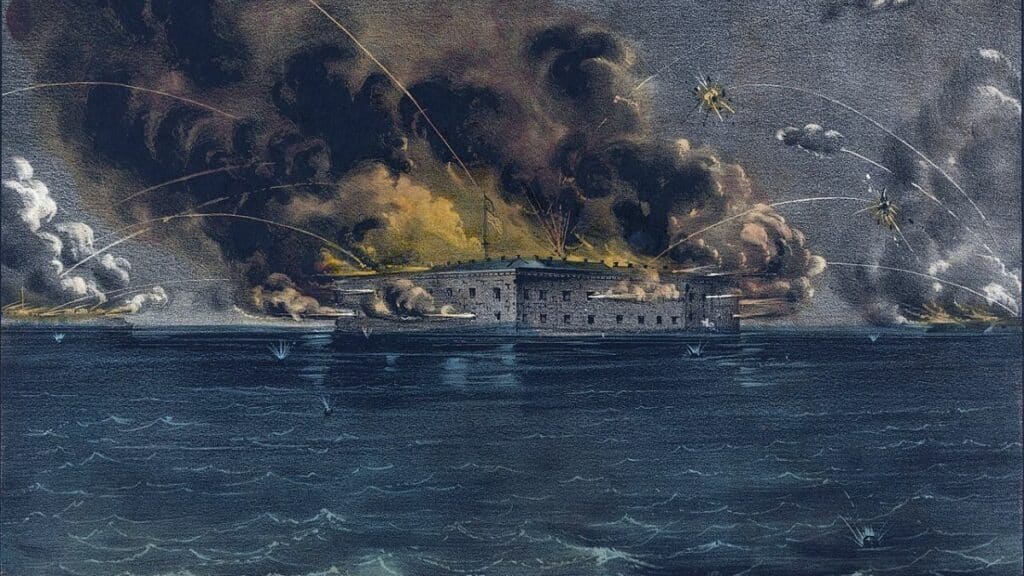
On April 12, 1861, the first shots of the Civil War were fired at Fort Sumter. The exchange between Confederate and Union forces marked the beginning of a prolonged and bloody conflict.
First Engagement
At 4:30 AM, Confederate batteries under General P.G.T. Beauregard began shelling Fort Sumter, located in Charleston Harbor, South Carolina.
The Union garrison, commanded by Major Robert Anderson, comprised approximately 85 soldiers.
They were ill-prepared and under-supplied due to the refusal of the Confederacy to allow resupply efforts.
The bombardment lasted 34 hours, with the fort receiving an estimated 3,000 shells. Despite the relentless attack, no casualties were on either side during the bombardment.
The Union forces attempted a limited return fire but faced significant challenges due to the limited munitions and structural damage.
Fort Sumter’s Surrender
By April 13, the situation had become untenable for the Union garrison. Supplies were critically low, and the fort was heavily damaged. Major Anderson, seeing no viable options, agreed to evacuate Fort Sumter.
A formal surrender was negotiated, and on April 14, Union troops left the fort. The Confederate forces had achieved their first victory, bolstering morale in the South and deepening the divide between North and South.
The fall of Fort Sumter galvanized public opinion, leading to calls for military action and the subsequent rallying of forces on both sides.
Fort Sumter After the Civil War
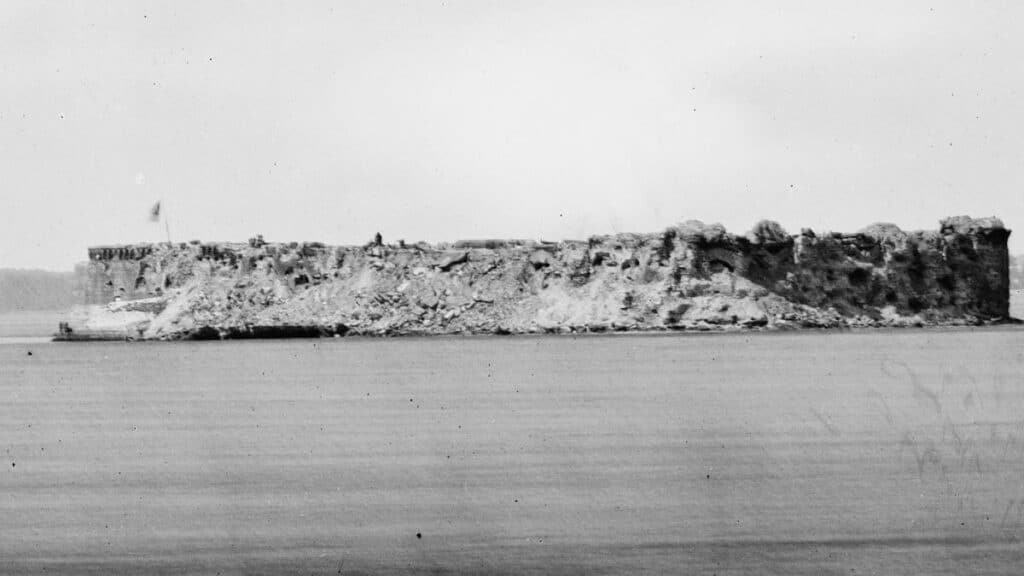
Fort Sumter underwent significant changes after the Civil War, reflecting its historical importance and evolving function.
Reconstruction and Later Use
Fort Sumter remained in ruins following the Civil War, requiring substantial repairs—the reconstruction efforts aimed to restore its structural integrity and prepare it for future use.
Military reinforcements were stationed to maintain security and stability during the Reconstruction period.
By World War I, Fort Sumter’s strategic military significance had diminished. It served various functions, including as a training and storage site.
During World War II, the fort contributed to coastal defense efforts, although advancements in warfare technology overshadowed its use.
Transformation into a National Monument
In 1948, Fort Sumter was designated as a National Monument, managed by the National Park Service. This transformation marked the beginning of its preservation as a historical site.
Efforts were made to protect and interpret the fort’s history.
Visitors can now explore the fort and learn its pivotal role in American history. Various educational programs and tours enhance the visitor experience and highlight the fort’s significance.
The Fort Sumter National Monument designation ensures its legacy is preserved for future generations.
Explore More: 10 Historic Forts in South Carolina
Cultural Impact and Memory
Fort Sumter’s cultural impact is significant, influencing historical interpretation and modern education. Its legacy continues through museums and educational programs that aim to preserve and share its historical importance.
Symbolism and Representation
Fort Sumter holds a powerful place in American history as the site where the first shots of the Civil War were fired. This moment began a profound and transformative period in the United States.
It is often seen as a symbol of the conflict between the Union and the Confederate States of America. The fort represents the larger issues of states’ rights and slavery, central to the war.
Its historical and symbolic significance makes it a central element in discussions about American identity and the lingering effects of the Civil War.
Artifacts from Fort Sumter are displayed in museums across the country, including the Fort Sumter Visitor Education Center in Charleston, South Carolina. These exhibits provide tangible connections to the past, allowing visitors to engage directly with history.
Education and Preservation
Educational programs play a crucial role in keeping Fort Sumter’s history alive. The National Park Service and various historical societies offer guided tours and educational materials highlighting the fort’s strategic importance during the Civil War.
Efforts to preserve Fort Sumter have been ongoing since the end of the Civil War. Preservation projects ensure the site remains intact for future generations to learn from and reflect upon.
The Fort Sumter Visitor Education Center is instrumental in these educational efforts, offering exhibits and information on the broader context of the Civil War, including the fort’s role and the larger issues at play.
This focused approach helps visitors better appreciate American history and the complexities surrounding the conflict.
Related Historic Sites
Fort Sumter is part of a network of historic sites that played crucial roles in American history. These sites include other seacoast fortifications and significant nearby landmarks that offer deeper insight into the region’s military past.
Other Seacoast Fortifications
Castle Pinckney: Located on Shute’s Folly Island in Charleston Harbor, this fort was pivotal during the War of 1812 and later used as a prison during the Civil War. Its brick masonry stands as a reminder of early American coastal defenses.
Fort Johnson: Situated on James Island, this fort is known for being where the first shot of the Civil War was fired. It offers a unique perspective on the war’s beginning and the strategic importance of Charleston Harbor.
Fort Pickens: Found on Santa Rosa Island in Florida, Fort Pickens played a critical role during the Civil War, remaining in Union hands throughout the conflict. Visitors can explore extensive fortifications and learn about its history through well-preserved structures and informative displays.
Significant Nearby Landmarks
Patriots Point: is a naval and maritime museum located in Mount Pleasant, South Carolina. It features the USS Yorktown, a World War II aircraft carrier, and other historic ships and exhibits highlighting naval history.
Samuel Francis Du Pont: A monument dedicated to the prominent Union naval officer in Wilmington, Delaware. Du Pont is known for his role in the capture of Port Royal. The monument gives visitors insights into his contributions to naval warfare.
Quincy Adams Gillmore: Known for his engineering skills, Gillmore led successful sieges, including capturing Fort Pulaski and operations against Charleston. Visitors at Fort Sumter can learn about his innovative tactics at the fort and nearby exhibits.
William T. Sherman: Famous for his “March to the Sea,” Sherman’s military campaigns deeply impacted the Civil War. Although his operations were primarily inland, his strategies and the resulting societal changes are often covered at historical sites like Fort Sumter, connecting broader Civil War themes to this coastal fort.

Cory is a website owner and content creator who enjoys fishing, history, coin collecting, and sports, among other hobbies. He is a husband and father of four.
Romans 15:4 For whatever was written in former days was written for our instruction, that through endurance and through the encouragement of the Scriptures we might have hope.

